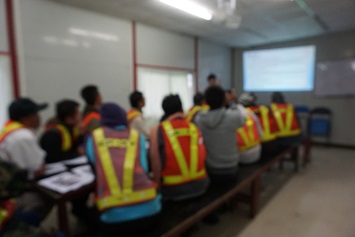Is your safety training ready for a post-pandemic return to normality? Do you have employees returning to on-site work who need refresher training or new hires who need initial safety training as part of the onboarding process?
As vaccination for COVID-19 continues to roll out across the country, you still need to adhere to mask or face covering and physical distancing recommendations during any initial or refresher training.
The bigger question about training is: Just how effective is safety training in reducing injuries, illnesses, and fatalities or workers’ compensation claims? The jury may still be out. Training really is just one element among many factors in workplace safety and health.
The National Institute for Occupational Safety and Health (NIOSH) several years ago looked into the research on training effectiveness and found that training does affect workers’ safety practices. However, it could not find definitive evidence for the impact of training alone on worker safety and health outcomes.
Occupational safety and health researchers rarely focus their studies exclusively on the impact of training. Most research looks at the impact of training along with other interventions like engineering or administrative hazard controls and personal protective equipment (PPE).
Regardless of the effectiveness of training, many Occupational Safety and Health Administration (OSHA) safety and health standards contain training requirements, and some even require maintaining records of training. Agency compliance safety and health officers (CSHOs) will look for training compliance, sometimes interviewing workers to gauge the level of safety training compliance. In fact, the fall protection training standard (29 CFR §1926.503) is one of the top 10 most frequently cited OSHA standards year after year.
During an inspection, CSHOs may find that not only are workers exposed to hazards like confined spaces and workplace chemicals, amputation hazards from equipment and machines, or struck-by hazards from forklifts, but workers also have not received training under the permit-required confined spaces (29 CFR §1910.146), control of hazardous energy (§1910.147), hazard communication (§1910.1200), powered industrial trucks (§1910.178), or other standards.
For example, if you’re cited by OSHA inspectors for failing to provide respiratory protection, you may also be cited for the lack of a respiratory protection training program, as well as the lack of a written program, medical evaluation, and initial and annual fit testing.
OSHA general industry standards with training requirements include hazard communication, standards for electrical safety, and several hazardous and toxic chemical substances, as well as:
- Emergency action plans and fire prevention plans;
- Powered platforms for building maintenance;
- Occupational noise exposure;
- Flammable liquids and explosive and blasting agents;
- Storage and handling of liquified petroleum gases and storage and handling of anhydrous ammonia;
- Process safety management of highly hazardous chemicals and hazardous waste operations and emergency response;
- PPE and respiratory protection;
- Temporary labor camps, accident prevention signs and tags, permit-required confined spaces, and control of hazardous energy (lockout/tagout);
- First aid and medical services;
- Fire protection, fire brigades, fixed fire extinguishing systems and portable fire extinguishers, fire detection systems and employee alarm systems, and standpipe and hose systems;
- Crawler locomotive and truck cranes, overhead and gantry cranes, powered industrial trucks, and servicing multipiece and single-piece rim wheels;
- Welding, cutting, and brazing requirements, as well as arc, oxygen-fuel gas, and resistance welding; and
- Special industries like commercial diving operations; electric power generation, transmission, and distribution; grain-handling facilities; laundry machinery and operations; logging; pulp, paper, and paperboard mills; and telecommunications.
Construction industry standards for blasting and explosives, cranes and derricks, falls, ladders and stairways, motor vehicles and mechanized equipment, scaffolds, steel erection, tools, and underground construction also contain training requirements. Many of the agriculture, maritime, and marine terminals industry standards also have training requirements.
OSHA 10 and OSHA 30 Training
OSHA’s Outreach Training Program is separate from training requirements of specific OSHA standards. The 10-hour and 30-hour training classes and the 10-hour and 30-hour cards for workers who complete training—often referred to as the “OSHA 10” and “OSHA 30” cards—cover the recognition, avoidance, abatement, and prevention of workplace hazards. Training also covers how the agency works, employer responsibilities and workers’ rights, and how to file a complaint. However, keep in mind that OSHA-10 and OSHA-30 training is not a substitute for the training requirements of specific OSHA standards.
There are OSHA 10-hour and 30-hour classes and completion cards in construction, general, and maritime industries, as well as trainer cards for construction, general, and maritime industries for those who complete “train the trainer” training. There also are 7.5-hour cards, 15-hour cards, and trainer cards for disaster site training.
The agency began a transition from paper cards to plastic cards in 2016.
Only OSHA-authorized trainers may conduct 10-hour and 30-hour classes and issue OSHA 10 and OSHA 30 cards. Trainers are independent service providers and not OSHA personnel.
Some fraudulent trainers may advertise OSHA 10-hour training but are not authorized to issue the 10-hour and 30-hour cards. For instance, a formerly authorized trainer admitted to selling more than 100 fake OSHA 10 cards at $200 each; he later entered a plea agreement with the U.S. Attorney’s Office for the District of New Jersey. OSHA maintains a watch list of suspended and revoked trainers who the agency found are not in compliance with the Outreach Training Program’s requirements.
The 10-hour course covers general safety and health hazards for entry-level workers. The 30-hour course is intended for supervisors and workers with safety and health responsibility and provides a greater variety of safety subjects and in-depth, industry-specific training.
The program has grown since OSHA launched it in 1971, and more than 5.21 million workers completed the training between fiscal year (FY) 2016 and FY 2020.
The Outreach Training Program is entirely voluntary, and the agency does not require that workers and supervisors have OSHA 10 and OSHA 30 completion cards. However, some employers and state and local governments may require a completion card as a condition of employment. OSHA cautions workers that the 10-hour and 30-hour classes and completion cards are not guarantees of employment.
The Disaster Site Worker Outreach Training Program is a training program for disaster site workers who provide skilled support services (such as debris removal, demolition, heavy equipment operation, or utility services) or site cleanup services in response to natural and man-made disasters. Disaster site training differs from construction, general, and maritime industry training and has a special focus on how to inspect, don, and doff air-purifying respirators.
COVID-19 Training
Safety training now also needs to cover infectious disease risks, especially COVID-19 risks and control measures. The federal COVID-19 guidelines recommend training that involves clearly communicating the risks of COVID-19 infection, as well as symptoms of the disease and the policies and procedures in place for workers’ protection.
COVID-19 is a respiratory disease caused by the SARS-CoV-2 virus.
State emergency temporary standards (ETSs) in place in California, Michigan, and Oregon contain training requirements, as does the permanent infectious disease standard in Virginia. A federal ETS may codify the recommendations of the existing guidelines or mirror some of the existing training requirements of the state standards.
The California ETS covers workers not already covered by the state’s aerosol transmissible disease (ATD) standard, which applies to correctional and healthcare facilities and emergency services. Employee training under the California ETS must cover how COVID-19 is spread and infection prevention techniques, as well as the specifics of the employer’s COVID-19 prevention program.
The Michigan ETS, now extended through October 14, requires employee training on COVID-19 and SARS-CoV-2, infection control practices, and the proper use of PPE. Employers also must maintain records of their employee COVID-19 training under the Michigan emergency rules.
Oregon’s ETS took effect on November 16, 2020 (a permanent rule has since been adopted). Oregon’s emergency rules require training that covers signs, symptoms, and transmission of COVID-19; health and safety practices and infection control measures to prevent transmission; mask, face covering, face shield, and physical distancing requirements; sanitation requirements; and the signs and symptoms reporting procedures, infection notification process, and medical removal.
Virginia requires that employers at facilities or worksites with hazards or job tasks classified as very high, high, or medium exposure risk provide their workers with training on the hazards and characteristics of the SARS-CoV-2 virus and COVID-19. They also must train workers on the requirements of Virginia’s standard; current guidelines from the Centers for Disease Control and Prevention (CDC) or state public health officials; safe work practices; the use, maintenance, and disposal of PPE; and details of the employers’ preparedness and response plan. Workers also must be trained in heat illness prevention when using PPE or face coverings. Virginia also requires employers to maintain records certifying each worker’s COVID-19 training.
You could be facing additional training and information compliance requirements due to the pandemic: compliance with hazard communication requirements for chemicals on the EPA’s “List N” of Disinfectants for Use Against SARS-CoV-2 (COVID-19). NIOSH last summer collected safety and health information for the cleaners and disinfectants on List N that employers can use in their hazard communication programs.
Business and employer guidance from the CDC and OSHA recommends the use of List N chemicals for business and workplace cleaning and sanitation, and the temporary and permanent state standards require it. Some of the chemicals on the EPA’s list have health or flammability hazards. If you use such cleaners and disinfectants, you will need to provide employee training, as well as maintain product labels and safety data sheets (SDSs).
Signs of Effective Training
COVID-19 and hazard communication training is just an additional pandemic-related complication in an already complex safety training picture. Basic safety training like the OSHA 10-hour Outreach Training Program class may be helpful in fostering employee safety awareness and compliance. However, many OSHA standards have specific training requirements, and agency inspectors will look for evidence of noncompliance during enforcement actions.
Training must be focused on the intended audience. You may need to take employees’ cultural and educational backgrounds into consideration, including language fluency and literacy levels. You may need to deliver training in a language other than English. OSHA, NIOSH, and even the labor union-supported Center for Construction Research and Training (CPWR) may be able to help with resources in Spanish and other languages.
Safety training is a key component of a safety and health management system, according to the American Society of Safety Professionals (ASSP). However, training is just one component and not a “set it and forget it” measure that ensures worker health and safety.



